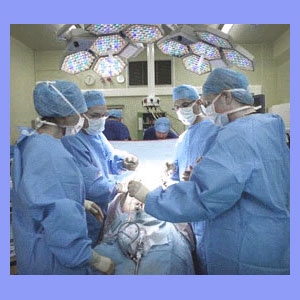
Discectomy for sciatica is a type of invasive surgical procedure in which part of a herniated or ruptured disc is removed from the body. This procedure is often recommended for patients with an MRI or CT scan verified herniated disc which is suspected of compressing a lumbar nerve root. There are many varieties of disc removal operation and discectomy is truly one of the most common surgical interventions which are used for resolving sciatica pain.
This dialog will profile the discectomy procedure and detail how it may be successful in treating nerve or spinal cord compression leading to painful sciatica expressions.
Discectomy for Sciatica Defined
Discectomy is a category of sciatica surgery which is used to remove offending bulges or ruptures from spinal discs. These herniations are most often blamed for causing radicular pain by compressing a nerve root as it leaves the spinal column. This process is medically termed foraminal stenosis, but is commonly called a pinched nerve. The disc bulge might also be blamed for pressuring the spinal cord or cauda equina instead, and in this case, the process is called spinal stenosis.
It is crucial to remember that many suspected disc pathologies are actually innocent of all blame. Intervertebral herniations are commonplace and often exist without causing any pain whatsoever. This is why it is of paramount importance to include your neurologist in the diagnostic process. They will help to make sure that the disc suspected of enacting pain is actually the cause, providing far better chances for successful surgical outcomes compared to patients who did not seek proper symptomatic correlation.
Types of Discectomy Surgery
The traditional version of the procedure is a full open surgery which is performed through a large incision in the back. The most invasive of these techniques might also include a full laminectomy to remove pieces of vertebral bone, as well as pieces of the affected disc.
Minimally invasive discectomy procedures, often called microdiscectomy or microendoscopic discectomy, can be performed without doing so much damage to healthy spinal tissues. These procedures are certainly advised for anyone even considering disc surgery as an option for sciatica treatment.
In the modern surgical arena, minimally invasive techniques are the general rule and can often be performed using truly inconspicuous anterior incisions which spare the entire back muscle anatomy from suffering any dissection.
Laser and endoscopic techniques have further refined discectomy, offering patients better results than ever before, as long as the diagnosis is sound and the procedure goes as planned.
Discectomy for Sciatica Results
This is definitely not the worst of the spinal operations, since that dubious honor goes to spinal fusion, but discectomy is still virtually unnecessary in the vast majority of back pain cases. Up to 95% of all back surgeries are not needed and most patients could and should be treated non-surgically.
Spinal surgery generally offers poor results for permanent pain resolution and often makes the symptoms far worse and the damage, unfortunately, sometimes irreparable. Every week, I get lots of letters from patients suffering from failed sciatica surgery syndrome, who are asking for advice. I hate to say it, but once the damage is done, the options are sometimes very limited. I just wish I could speak to these same people before they made the fateful decision to undergo surgery for their sciatica.
Ok, just to make this article super clear: You probably do not need surgery. Your surgeon may have advised surgery, but do not be surprised. They are surgeons, operating is what they do.
Surgery might help and then again it might not. It might make things a whole lot worse. Be very careful. If you do decide to proceed, try to use a minimally invasive form of discectomy to lessen the chances of permanent injury to your spine and musculature. As mentioned earlier, do not even seriously consider any type of surgical intervention until you are 100% sure that the diagnosis of the disc issue is completely accurate. If not, you are certainly setting yourself up for the worst possible chances at achieving a cure.





